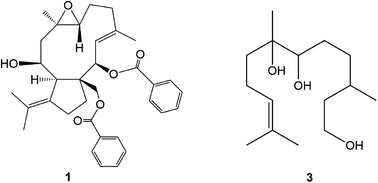Chemical constituents from the seeds of Nigella glandulifera and their hypoglycemic activities†
Abstract
The seeds of Nigella glandulifera Freyn et Sint. are traditional Uygur medicine used for the treatment of diabetes. However, the active anti-diabetic constituents in the seeds of N. glandulifera remain unclear. In the present study, a new delabellane-type diterpene, 8-denicotinoylnigellamine A1 (1), and a new acyclic sesquiterpene, 2,6,10-trimethyl-6,7,12-trihydroxy-dodec-2-ene (3), together with eight known compounds including alkaloids (2 and 7), triterpenoid saponins (4–6), and phenolic compounds (8–10), were isolated from the seeds of N. glandulifera. Their structures were determined by extensive spectroscopic analyses and quantum chemical calculations. We evaluated the potential protective effects of the isolated compounds on an insulin resistant HepG2 (IR-HepG2) cell model. The results showed that compounds 2, 4–8, and 10 could promote the consumption of glucose in IR-HepG2 cells. Those compounds might be responsible for the anti-diabetic effects of the seeds of N. glandulifera.



 Please wait while we load your content...
Please wait while we load your content...